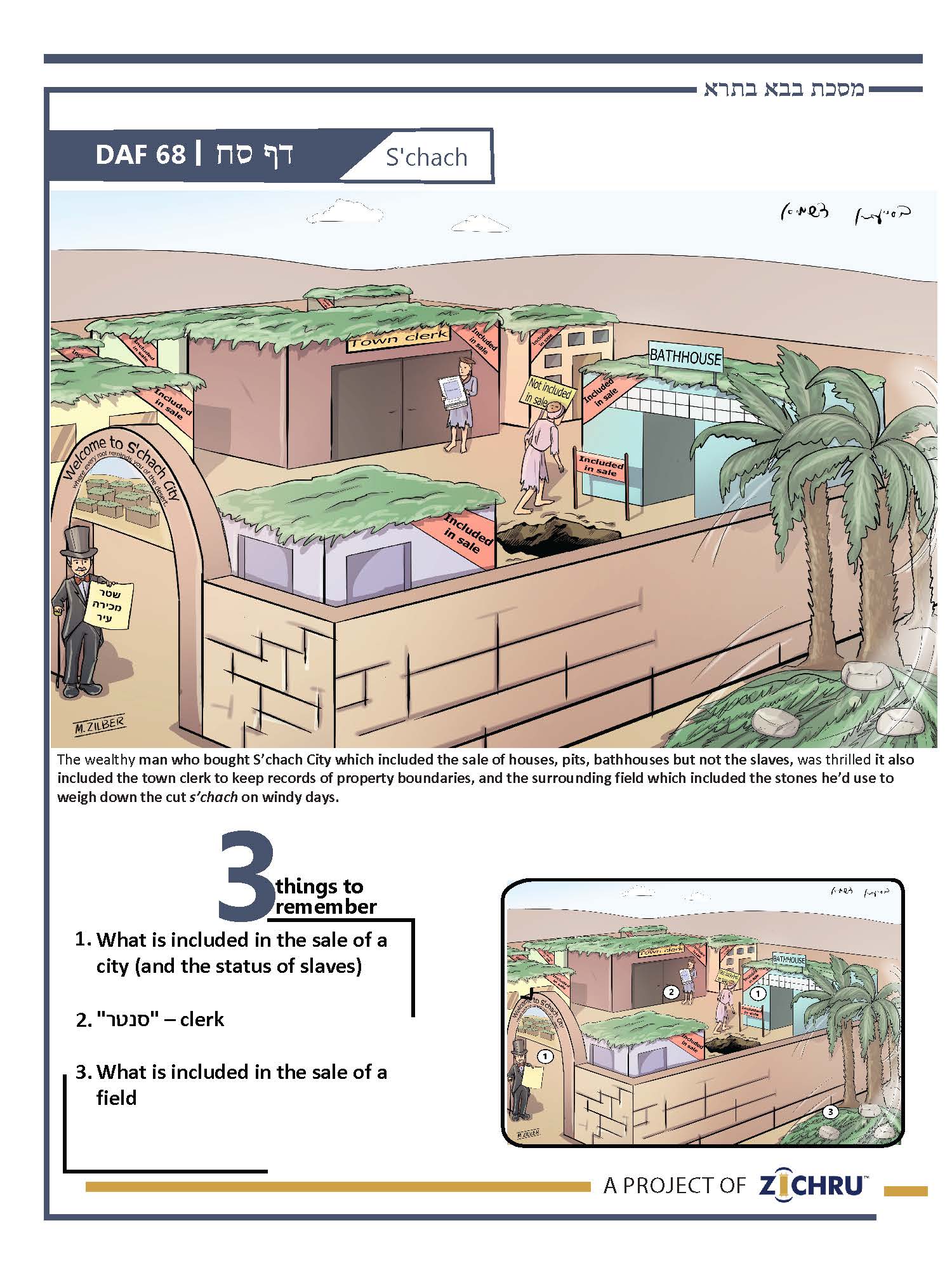Bava Basra - Daf 68
- Audio Timestamps
0:00 - The 3 Sugyos
2:43 - Review of 3 Sugyos
5:12- Siman
8:03 - 4 Blatt Back Chazarah
15:06 - Pop Quiz (Last 7 blatt)
For access to all Zichru resources including PDFs, and illustrations CLICK HERE
- What is included in the sale of a city (and the status of slaves)
The next Mishnah states: המוכר את העיר – One who sells a city, מכר בתים בורות שיחין ומערות – he sells its houses, pits, cisterns, and vaults, as well as its bathhouses, dovecots, olive presses, and בית השלחין (defined later as either fields requiring irrigation, or gardens). If he says he is selling “it and everything in it,” אפילו היו בה בהמה ועבדים – even if there were animals and slaves in [the city], they are included in the sale. This implies that slaves are normally not sold with the city, and Rav Acha brei d’Rav Avya said to Rav Ashi that this should prove עבדא כמטלטלא דמי – slaves are considered by people as movable property (despite halachically having the status of land), because otherwise, they should be included in the sale of the city!? Rav Ashi responded by proving from the Mishnah that even if they are like מטלטלין, they are different from ordinary מטלטלין because they move on their own. Therefore, it is possible that slaves are like קרקע, but are still not included in the city’s sale, because שאני בין מקרקע דנייד למקרקע דלא נייד – there is a difference between קרקע which moves and inanimate קרקע.
- "סנטר" – clerk, or surrounding fields?
In the Mishnah, Rabban Shimon ben Gamliel said that one who sells a city automatically sells the "סנטר". In Bavel, they said that this means: בר מחווניתא – a town clerk (i.e., a slave who keeps records of the boundaries of people’s properties in the city). Shimon ben Avtulmus said it means: באגי – the fields surrounding the city. The Gemara explains that according to the opinion that Rabban Shimon ben Gamliel is including even the town clerk in the sale, he certainly would include these fields, which are unmovable. According to the opinion he is referring to fields, he would not include the clerk, who is movable, in the sale of the city. In a Baraisa, Rebbe Yehudah discusses what is included in the city’s sale. According to the Gemara’s emendation, he says that a "סנטר" is sold with the city, like Rabban Shimon ben Gamliel, but not the אנקולמוס – king’s scribe, who records the number of fields, houses, and people in the city for tax collection purposes.
- What is included in the sale of a field
The next Mishnah states about one who sold a field: מכר את האבנים שהם לצרכה – he sold the stones which are for [the field’s] needs (which the Gemara will define). Although they are detached, they are never removed from the field, and considered attached to it. ואת הקנים שבכרם שהם לצרכו – He also sold the reeds of the vineyard which are for its needs, and the Rashbam infers that the vineyard itself is certainly sold as well. He has also sold התבואה שהיא מחוברת לקרקע - the produce which is attached to the ground, a thicket of reeds smaller than a quarter-kav, and a watchman’s hut which is not plastered with clay. In addition to ordinary trees, he also sold a חרוב שאינו מורכב – carob tree which has not yet been grafted, and בתולת השקמה – a virgin (i.e., unpruned) sycamore tree. If he said he is selling “it and everything in it,” then he includes stones and reeds which are not prepared for the needs of the field or vineyard (respectively), as well as detached produce. Still, this does not include a thicket larger than a quarter-kav, a plastered watchman’s hut, a carob tree which has been grafted, or a pruned sycamore tree. The Rashbam explains that these four items are considered independent properties.
Siman – S’chach
The wealthy man who bought S’chach City which included the sale of houses, pits, bathhouses but not the slaves, was thrilled it also included the town clerk to keep records of property boundaries, and the surrounding field which included the stones he’d use to weigh down the cut s’chach on windy days.


